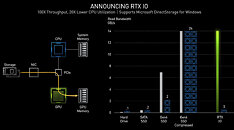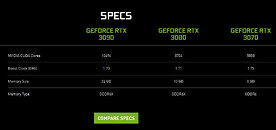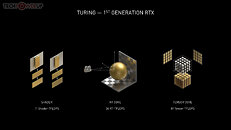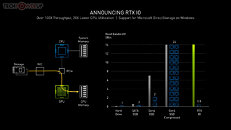- Joined
- Oct 9, 2007
- Messages
- 47,449 (7.50/day)
- Location
- Hyderabad, India
| System Name | RBMK-1000 |
|---|---|
| Processor | AMD Ryzen 7 5700G |
| Motherboard | ASUS ROG Strix B450-E Gaming |
| Cooling | DeepCool Gammax L240 V2 |
| Memory | 2x 8GB G.Skill Sniper X |
| Video Card(s) | Palit GeForce RTX 2080 SUPER GameRock |
| Storage | Western Digital Black NVMe 512GB |
| Display(s) | BenQ 1440p 60 Hz 27-inch |
| Case | Corsair Carbide 100R |
| Audio Device(s) | ASUS SupremeFX S1220A |
| Power Supply | Cooler Master MWE Gold 650W |
| Mouse | ASUS ROG Strix Impact |
| Keyboard | Gamdias Hermes E2 |
| Software | Windows 11 Pro |
NVIDIA just announced its new generation GeForce "Ampere" graphics card series. The company is taking a top-to-down approach with this generation, much like "Turing," by launching its two top-end products, the GeForce RTX 3090 24 GB, and the GeForce RTX 3080 10 GB graphics cards. Both cards are based on the 8 nm "GA102" silicon. Join us as we live blog the pre-recorded stream by NVIDIA, hosted by CEO Jen-Hsun Huang.





Update 16:04 UTC: Fortnite gets RTX support. NVIDIA demoed an upcoming update to Fortnite that adds DLSS 2.0, ambient occlusion, and ray-traced shadows and reflections. Coming soon.


Update 16:06 UTC: NVIDIA Reflex technology works to reduce e-sports game latency. Without elaborating, NVIDIA spoke of a feature that works to reduce input and display latencies "by up to 50%". The first supported games will be Valorant, Apex Legends, Call of Duty Warzone, Destiny 2 and Fortnite—in September.

Update 16:07 UTC: Announcing NVIDIA G-SYNC eSports Displays—a 360 Hz IPS dual-driver panel that launches through various monitor partners in this fall. The display has a built-in NVIDIA Reflex precision latency analyzer.

Update 16:07 UTC: NVIDIA Broadcast is a brand new app available in September that is a turnkey solution to enhance video and audio streaming taking advantage of the AI capabilities of GeForce RTX. It makes it easy to filter and improve your video, add AI-based backgrounds (static or animated), and builds on RTX Voice to filter out background noise from audio.

Update 16:10 UTC: Ansel evolves into Omniverse Machinima, an asset exchange that helps independent content creators to use game assets to create movies. Think fan-fiction Star Trek episodes using Star Trek Online assets. Beta in October.


Update 16:15 UTC: Updates to the AI tensor cores and RT cores. In addition to more numbers of RT- and tensor cores, the 2nd generation RT cores and 3rd generation tensor cores offer higher IPC. Making ray-tracing have as little performance impact as possible appears to be an engineering goal with Ampere.

Update 16:18 UTC: Ampere 2nd Gen RTX technology. Traditional shaders are up by 270%, raytracing units are 1.7x faster and the tensor cores bring a 2.7x speedup.


Update 16:19 UTC: Here it is! Samsung 8 nm and Micron GDDR6X memory. The announcement of Samsung and 8 nm came out of nowhere, as we were widely expecting TSMC 7 nm. Apparently NVIDIA will use Samsung for its Ampere client-graphics silicon, and TSMC for lower volume A100 professional-level scalar processors.


Update 16:20 UTC: Ampere has almost twice the performance per Watt compared to Turing!

Update 16:21 UTC: Marbles 2nd Gen demo is jaw-dropping! NVIDIA demonstrated it at 1440p 30 Hz, or 4x the workload of first-gen Marbles (720p 30 Hz).

Update 16:23 UTC: Cyberpunk 2077 is playing big on the next generation. NVIDIA is banking extensively on the game to highlight the advantages of Ampere. The 200 GB game could absorb gamers for weeks or months on end.

Update 16:24 UTC: New RTX IO technology accelerates the storage sub-system for gaming. This works in tandem with the new Microsoft DirectStorage technology, which is the Windows API version of the Xbox Velocity Architecture, that's able to directly pull resources from disk into the GPU. It requires for game engines to support the technology. The tech promises a 100x throughput increase, and significant reductions in CPU utilization. It's timely as PCIe gen 4 SSDs are on the anvil.

Update 16:26 UTC: Here it is, the GeForce RTX 3080, 10 GB GDDR6X, running at 19 Gbps, 238 tensor TFLOPs, 58 RT TFLOPs, 18 power phases.

Update 16:29 UTC: Airflow design. 90 W more cooling performance than Turing FE cooler.

Update 16:30 UTC: Performance leap, $700. 2x as fast as RTX 2080, available September 17. Up to 2x faster than the original RTX 2070.

Update 17:05 UTC: GDDR6X was purpose-developed by NVIDIA and Micron Technology, which could be an exclusive vendor of these chips to NVIDIA. These chips use the new PAM4 encoding scheme to significantly increase data-rates over GDDR6. On the RTX 3090, the chips tick at 19.5 Gbps (data rates), with memory bandwidths approaching 940 GB/s.

Update 16:31 UTC: RTX 3070, $500, faster than RTX 2080 Ti, 60% faster than RTX 2070, available in October. 20 shader TFLOPs, 40 RT TFLOPs, 163 tensor cores, 8 GB GDDR6

Update 16:33 UTC: Call of Duty: Black Ops Cold War is RTX-on.



Update 16:35 UTC: RTX 3090 is the new TITAN. Twice as fast as RTX 2080 Ti, 24 GB GDDR6X. The Giant Ampere. A BFGPU, $1500 available from September 24. It is designed to power 60 fps at 8K resolution, up to 50% faster than Titan RTX.
Update 16:43 UTC: Wow, I want one. On paper, the RTX 3090 is the kind of card I want to upgrade my monitor for. Not sure if a GPU ever had that impact.

Update 16:59 UTC: Insane CUDA core counts, 2-3x increase generation-over-generation. You won't believe these.

Update 17:01 UTC: GeForce RTX 3090 in the details. Over Ten Thousand CUDA cores!

Update 17:02 UTC: GeForce RTX 3080 details. More insane specs.

Update 17:03 UTC: The GeForce RTX 3070 has more CUDA cores than a TITAN RTX. And it's $500. Really wish these cards came out in March. 2020 would've been a lot better.

Here's a list of the top 10 Ampere features.
Update 19:22 UTC: For a limited time, gamers who purchase a new GeForce RTX 30 Series GPU or system will receive a PC digital download of Watch Dogs: Legion and a one-year subscription to the NVIDIA GeForce NOW cloud gaming service.
Update 19:47 UTC: All Turing cards support HDMI 2.1. The increased bandwidth provided by HDMI 2.1 allows, for the first time, a single cable connection to 8K HDR TVs for ultra-high-resolution gaming. Also supported is AV1 video decode.
Update 20:06 UTC: Added the complete NVIDIA presentation slide deck at the end of this post.
Update Sep 2nd: We received following info from NVIDIA regarding international pricing:



























































View at TechPowerUp Main Site





Update 16:04 UTC: Fortnite gets RTX support. NVIDIA demoed an upcoming update to Fortnite that adds DLSS 2.0, ambient occlusion, and ray-traced shadows and reflections. Coming soon.


Update 16:06 UTC: NVIDIA Reflex technology works to reduce e-sports game latency. Without elaborating, NVIDIA spoke of a feature that works to reduce input and display latencies "by up to 50%". The first supported games will be Valorant, Apex Legends, Call of Duty Warzone, Destiny 2 and Fortnite—in September.

Update 16:07 UTC: Announcing NVIDIA G-SYNC eSports Displays—a 360 Hz IPS dual-driver panel that launches through various monitor partners in this fall. The display has a built-in NVIDIA Reflex precision latency analyzer.

Update 16:07 UTC: NVIDIA Broadcast is a brand new app available in September that is a turnkey solution to enhance video and audio streaming taking advantage of the AI capabilities of GeForce RTX. It makes it easy to filter and improve your video, add AI-based backgrounds (static or animated), and builds on RTX Voice to filter out background noise from audio.

Update 16:10 UTC: Ansel evolves into Omniverse Machinima, an asset exchange that helps independent content creators to use game assets to create movies. Think fan-fiction Star Trek episodes using Star Trek Online assets. Beta in October.


Update 16:15 UTC: Updates to the AI tensor cores and RT cores. In addition to more numbers of RT- and tensor cores, the 2nd generation RT cores and 3rd generation tensor cores offer higher IPC. Making ray-tracing have as little performance impact as possible appears to be an engineering goal with Ampere.

Update 16:18 UTC: Ampere 2nd Gen RTX technology. Traditional shaders are up by 270%, raytracing units are 1.7x faster and the tensor cores bring a 2.7x speedup.


Update 16:19 UTC: Here it is! Samsung 8 nm and Micron GDDR6X memory. The announcement of Samsung and 8 nm came out of nowhere, as we were widely expecting TSMC 7 nm. Apparently NVIDIA will use Samsung for its Ampere client-graphics silicon, and TSMC for lower volume A100 professional-level scalar processors.


Update 16:20 UTC: Ampere has almost twice the performance per Watt compared to Turing!

Update 16:21 UTC: Marbles 2nd Gen demo is jaw-dropping! NVIDIA demonstrated it at 1440p 30 Hz, or 4x the workload of first-gen Marbles (720p 30 Hz).

Update 16:23 UTC: Cyberpunk 2077 is playing big on the next generation. NVIDIA is banking extensively on the game to highlight the advantages of Ampere. The 200 GB game could absorb gamers for weeks or months on end.

Update 16:24 UTC: New RTX IO technology accelerates the storage sub-system for gaming. This works in tandem with the new Microsoft DirectStorage technology, which is the Windows API version of the Xbox Velocity Architecture, that's able to directly pull resources from disk into the GPU. It requires for game engines to support the technology. The tech promises a 100x throughput increase, and significant reductions in CPU utilization. It's timely as PCIe gen 4 SSDs are on the anvil.

Update 16:26 UTC: Here it is, the GeForce RTX 3080, 10 GB GDDR6X, running at 19 Gbps, 238 tensor TFLOPs, 58 RT TFLOPs, 18 power phases.

Update 16:29 UTC: Airflow design. 90 W more cooling performance than Turing FE cooler.

Update 16:30 UTC: Performance leap, $700. 2x as fast as RTX 2080, available September 17. Up to 2x faster than the original RTX 2070.

Update 17:05 UTC: GDDR6X was purpose-developed by NVIDIA and Micron Technology, which could be an exclusive vendor of these chips to NVIDIA. These chips use the new PAM4 encoding scheme to significantly increase data-rates over GDDR6. On the RTX 3090, the chips tick at 19.5 Gbps (data rates), with memory bandwidths approaching 940 GB/s.

Update 16:31 UTC: RTX 3070, $500, faster than RTX 2080 Ti, 60% faster than RTX 2070, available in October. 20 shader TFLOPs, 40 RT TFLOPs, 163 tensor cores, 8 GB GDDR6

Update 16:33 UTC: Call of Duty: Black Ops Cold War is RTX-on.



Update 16:35 UTC: RTX 3090 is the new TITAN. Twice as fast as RTX 2080 Ti, 24 GB GDDR6X. The Giant Ampere. A BFGPU, $1500 available from September 24. It is designed to power 60 fps at 8K resolution, up to 50% faster than Titan RTX.
Update 16:43 UTC: Wow, I want one. On paper, the RTX 3090 is the kind of card I want to upgrade my monitor for. Not sure if a GPU ever had that impact.

Update 16:59 UTC: Insane CUDA core counts, 2-3x increase generation-over-generation. You won't believe these.

Update 17:01 UTC: GeForce RTX 3090 in the details. Over Ten Thousand CUDA cores!

Update 17:02 UTC: GeForce RTX 3080 details. More insane specs.

Update 17:03 UTC: The GeForce RTX 3070 has more CUDA cores than a TITAN RTX. And it's $500. Really wish these cards came out in March. 2020 would've been a lot better.

Here's a list of the top 10 Ampere features.
Update 19:22 UTC: For a limited time, gamers who purchase a new GeForce RTX 30 Series GPU or system will receive a PC digital download of Watch Dogs: Legion and a one-year subscription to the NVIDIA GeForce NOW cloud gaming service.
Update 19:47 UTC: All Turing cards support HDMI 2.1. The increased bandwidth provided by HDMI 2.1 allows, for the first time, a single cable connection to 8K HDR TVs for ultra-high-resolution gaming. Also supported is AV1 video decode.
Update 20:06 UTC: Added the complete NVIDIA presentation slide deck at the end of this post.
Update Sep 2nd: We received following info from NVIDIA regarding international pricing:
- UK: RTX 3070: GBP 469, RTX 3080: GBP 649, RTX 3090: GBP 1399
- Europe: RTX 3070: EUR 499, RTX 3080: EUR 699, RTX 3090: EUR 1499 (this might vary a bit depending on local VAT)
- Australia: RTX 3070: AUD 809, RTX 3080: AUD 1139, RTX 3090: AUD 2429



























































View at TechPowerUp Main Site







